Brave Calliope
Greg Martin
Liberty Wildlife Contributor
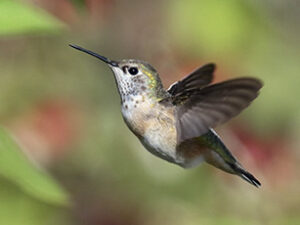
The smallest bird in North America weighs less than a penny, but annually travels the full length of the continent in search of the best seasonal grounds. That is a titanic undertaking, no matter one’s size. But for a pint-sized wanderer, it’s practically mythic.
The Calliope Hummingbird is as bold as it is minuscule. It defends its nest with great fierceness, to such an unbelievable extent that Cornell University cites documented cases of Calliopes recklessly attacking Red-tailed Hawks in order to drive them away.[1]Such premeditated shrimp-on-leviathan aggression is by no means unheard of in the feathered world. Larger, less agile raptors quite often find themselves at the mercy of tiny bullies; sparrows, finches, hummingbirds, and other Lilliputian warriors have an innate sense of which birds of prey can catch them and which cannot, and in doing so wield the awesome power of annoyance to drive these predators away. In that same aggressive spirit, this titan dominates the treetops of its forest home as fully as any sprite has a right to do.
As unassuming as it is, the Calliope is not the smallest bird in the world. Not quite. That actually belongs to an even slighter hummingbird, the Bee Hummingbird of Cuba, which, as its name suggests, is so modest in stature that it sometimes gets mistaken for an overly feathered bumblebee.[2]While the world’s littlest avian has a habitat to match, the Calliope claims half the Americas as its sovereign domain. It’s a long trip from Canada to Mexico; yet no matter where it rests, the Calliope looks out upon its surroundings as the unquestioned master of any flower its tiny spear of a beak can reach.
Arizona falls along its migration path, meaning that our state has the privilege of (temporarily) accommodating both the largest and smallest birds in North America. California Condors of the Grand Canyon might seem the more impressive of the two, casting behemoth, near prehistoric-looking shadows as they soar above the Colorado River, but the Calliope knows how to travel in style: males sport brilliant magenta throat plumages that practically scream to the world, “Here I am! Love me! Fear me!” And more typically, “Choose me as a mate!”
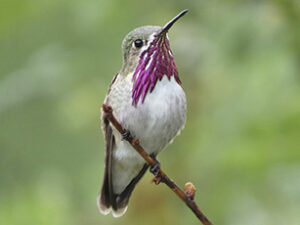
The weightiest part of this avian is its name. Contrary to expectations for a bird so physically insignificant, its name is a foundational pillar of Western Civilization: Calliope, mythological daughter of Zeus and chief of the nine Muses whom the ancient Greeks looked to for inspiration in the arts, was associated with no less a medium than epic poetry itself. When you see this bird, all three inches of it, think Homer: think the Iliad and the Odyssey, the theft of Helen and the sack of Troy, then picture this hummingbird heroically charting a path through the heart of the Rocky Mountains, which many of them do each year. Like a tiny Odysseus, it navigates the breadth of its world in search of home, wherever it happens to be. That’s a quest every creature, no matter how large, can appreciate, and one done on such a magnitude that the only proper response is to stand and gape at the take-no-prisoners, fear-no-raptor, dressed-for-success dynamo named Calliope.
[1]https://www.allaboutbirds.org/guide/Calliope_Hummingbird
[2]https://www.audubon.org/news/get-know-bee-hummingbird-worlds-smallest-bird
Beautiful Beast
Gail Cochrane
Liberty Wildlife Volunteer
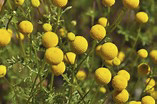
Have you seen the bright yellow blooms of the globe chamomile abounding in the desert this year? I spent some time trying to find the round ball-like flowers in my field guides and finally discovered the globe chamomile, pretty posy that it is, is a destructive and aggressive invasive plant.
In fact, Maricopa County is a hot spot for infestation of this scourge, prodigious in growth and seed dispersal. A timeline of the plant’s spread here dates back to the 1990’s. Globe chamomile’s designation as an Arizona Noxious Weed was proposed to the Arizona State legislature in 2007 after significant spread of the plant was noticed at Ben Avery Shooting Range, the Cave Creek Ranger Station and parts of Tonto Forest. Noxious weed status has still not been conferred, although the issue is before the current legislature again this month.
Globe chamomile thrives in wet winter years, favoring rainfall between December and May just like all of our native annuals. The moist winter of 2016/17 created infestations spreading from Cave Creek to Mesa. That year globe chamomile was even found growing from cracks in the sidewalks of Central Phoenix.
The seeds of the plant ripen and disperse from February to May, peaking in late March and April. The infestation at the Ben Avery facility continued unimpeded for 15 years with the seed ripening coinciding with the annual Arizona Outdoors Expo. Thousands of unknowing outdoor enthusiasts carried seeds away on clothing, shoes, and in vehicles to their favorite outdoor places for many years. The seeds also have an impressive ability to disperse in the air. It’s a plot worthy of the creepiest apocalypse movie.
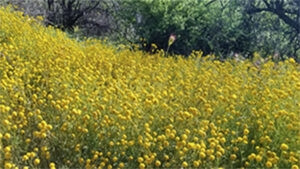
After our lovely wet winter this past year, there has been a massive emergence of the “beautiful beast”. Globe chamomile or Oncosiphon piluliferum originates in South Africa. Current hot spots for its spread include Maricopa County and Riverside City, Ca. It is easily established in disturbed soils and will crowd out native plants. It is best pulled and bagged for disposal, but in larger areas the herbicide Garlon or trichlopyr could be considered. Glysophate is not effective. Mostly, people need to be aware that this is not a plant we want in the Sonoran Desert. Do what you can to help, whether it’s spreading the word, pulling some plants or organizing an eradication mission!
Content for this article was drawn from a January 2019 presentation by John Scheuring, Conservation Committee Chairman for the Arizona Native Plant Society.
“ANTING” BEHAVIOR IN BIRDS
Claudia Kirscher
Liberty Wildlife Volunteer

Hundreds of bird species engage in anting behavior, including ravens, magpies, songbirds, great-horned owls, wild turkeys, and mockingbirds to name a few. Birds will either rub their feathers with a beak-held ant (and then eat the ant) or lie on top of an ant hill with wings spread in a posture similar to dust bathing or sunning, allowing the ants to crawl freely throughout their feathers.
This odd-looking behavior has yet to be fully explained or proven and there are many proposed explanations.
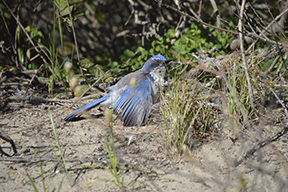
Ants containing formic acid are preferred, but occasionally millipedes will be used. These insects secrete liquids containing defense chemicals such as formic acid. The acids could act as an insecticide or fungicide and inhibit mites and feather parasites. Anting is more frequently done during molting season. Could this have a soothing effect on the skin during the discomfort of molting and rapid growth of new feathers?
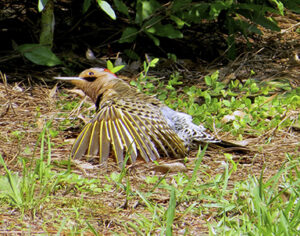
Birds have also been observed anting with marigolds (which contain the natural insecticide pyrethrum) and even with mothballs (which contain the insecticide naphthalene).
No matter what the reason, it is a fascinating avian behavior not often observed in the wild. Should you be fortunate to witness a bird engaging in anting, stop, look, and marvel at one of the intricacies of nature.
Enjoy this YouTube video of an American Robin on an anthill, rubbing ants on its feathers.
https://www.youtube.com/watch?v=b8ldq-V47i0
Resources and further reading: Birdwatchingdaily.com/blog ; Wikipedia.com ; npr.org ; birds.com/blog
Kid Stuff
Carol Suits
Nurturing Nature

Did You Know?
Birds are busy building some amazing nests. The Cactus Wren, official bird of Arizona, has figured out how to keep chicks warm during cool months and cool during the hot months. This bird can only be found in the Southwest and Mexico.
https://www.desertmuseum.org/kids/oz/long-fact-sheets/Cactus%20Wren.php
https://www.birdnote.org/show/cactus-wren-nest-orientation
https://www.birdnote.org/video/2017/04/cactus-wrens-calling
Discover more about Calliope Hummingbirds!
https://www.allaboutbirds.org/guide/Calliope_Hummingbird/overview
This jigsaw puzzle shows a male Calliope. Can you find pictures on the www.allaboutbirds website of a female or juvenile Calliope?
https://www.jigsawplanet.com/?rc=play&pid=0a916670fcfc
Here’s an easy way to draw a hummingbird
https://www.youtube.com/watch?v=SA6Dt7ndmyM&list=UUuLXeJAKL-FL-wJBNqLbubQ
What is anting? Why do some birds love to do this?
http://academickids.com/encyclopedia/index.php/Anting_(bird_activity)
Watch this video showing a thrasher anting.


